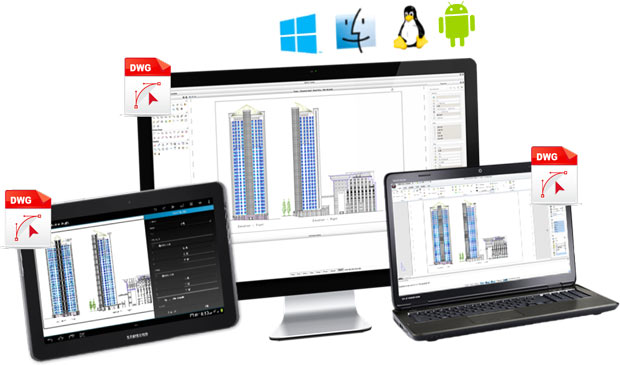
Graebert offers an all-devices approach to design. Image courtesy of Graebert Software.
Latest News
October 28, 2015
Although 3D solid modeling mechanical CAD on the PC has been available for more than 20 years, demand remains strong for 2D CAD solutions for product design and factory management. Exact figures are hard to come by, but industry analysts generally estimate there are almost as many copies of 2D software in regular use for manufacturing as 3D. CAD management consultant Robert Green believes 40% of all product design and manufacturing CAD work is still done using 2D software.
Autodesk remains the market leader for 2D product design and manufacturing, but it is not the only player. Two developer conferences held this October in Germany brought together a wide range of small third-party developers and a few well-known brands that share a common interest in supporting the DWG-compatible CAD market independent of Autodesk. Graebert Software (Oct. 6-9) and Bricsys (Oct. 13-14) both create software that supports the DWG format popularized by Autodesk. Neither has been content to limit themselves to the idea of simply being low-cost clones of AutoCAD. Their product specifics and target markets vary, but each has carved out a lucrative market by helping to keep DWG-based drafting and modeling alive in the 21st century. To some, the most surprising aspect may be their aspirations to be known for their 3D features as much as for their compatibility with the DWG file format.
Graebert: Millions of 2D CAD Seats
Graebert is a CAD vendor with an identity problem. There are more than 1 million active users of its software, yet only a small percentage knows the vendor behind their software. Most of them are SOLIDWORKS and CATIA users who take advantage of free or paid versions of DraftSight CAD distributed by Dassault Systèmes. Some use DraftSight to edit legacy drawings, others start designs in it then move the 2D drawings into 3D CAD for detailed modeling, or move 3D views into DraftSight to create production drawings.
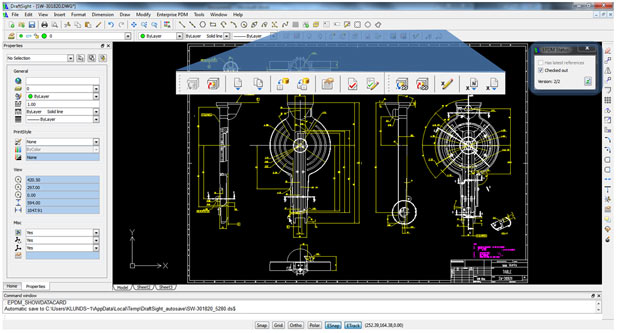 DraftSight is distributed by Dassault Systèmes as part of the SOLIDWORKS portfolio, but Graebert Software is the developer. Image courtesy of Dassault Systèmes.
DraftSight is distributed by Dassault Systèmes as part of the SOLIDWORKS portfolio, but Graebert Software is the developer. Image courtesy of Dassault Systèmes.Not only are more than 1 million people using DraftSight on a regular basis, but more than 380,000 companies have established corporate accounts, which gives them discounts on a per-seat purchase of DraftSight Professional, plus maintenance and support.
Graebert’s CAD engine Ares is also the basis of CorelCAD from Corel Software (best known for CorelDraw), and Graebert’s own Ares Commander CAD for Windows, Mac, and Linux. Earlier this year Onshape, the new cloud-based 3D CAD program launched by some founders of SOLIDWORKS, became a Graebert client. Onshape says 2D drawing was the most requested feature not included when the product first opened for beta use earlier this year. Graebert developers were the first to use the new Onshape API (application programming interface), which will be released to end users “soon.”
All together Graebert has 1 million paying users, 3 million registered users, and more than 8 million downloads of its CAD software, counting all the versions as distributed by the various vendors. Graebert CEO Wilfried Graebert says he prefers keeping his company in the background. “We are not a sales-driven company; we prefer our partners to provide the sales and marketing channel.” Although unrelated to product engineering, Graebert announced at its developers conference its newest partner, GIS giant ESRI. Ares Map will be sold by the ESRI sales channel, a force as powerful and loyal as the SOLIDWORKS dealer network.
Andreas Kulik manages the Graebert relationship for Dassault Systèmes as the SOLIDWORKS director of product portfolio and business development. Kulik says having a partner focus on 2D technology makes it easier for the 3D-driven SOLIDWORKS team to satisfy its customer base. “2D is still the standard for documentation,” says Kulik. “Our customers think of DraftSight as a professional-grade 2D solution ... they want to do more with extensions and [a DraftSight-specific] API.”
Graebert is also developing its own mechanical CAD product. Ares Mechanical is expected to launch for open beta testing before the end of 2015. In a case of scratching each other’s back, Graebert has licensed Constraint Design Solver technology from Dassault Systèmes’ subsidiary Spatial Corp. for use in the product.
Mobile as the Next Frontier
Mobile technology is changing the nature of computing, and CAD is no exception. The power and convenience of access anywhere for consumer-class applications is putting pressure on the makers of professional tools to keep up. Right now there are only three mobile CAD products with any real impact in the market, according to 2D CAD industry analyst Ralph Grabowski: AutoCAD 360, IMSI/Design TurboSite, and Graebert Ares Touch. Unlike the others, Graebert’s mobile CAD was developed first for Android.
Putting CAD on a mobile device is a daunting challenge. Its complex algorithms demand computational horsepower; the large files can quickly fill onboard storage; and the lack of a keyboard and mouse make user interface design perhaps the most demanding aspect of moving CAD to mobile.
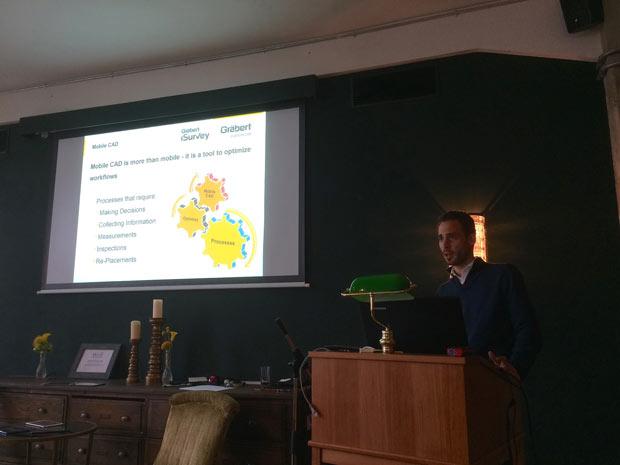 Felix Graebert shares the reasons for moving CAD to mobile devices at the recent Graebert Developers Conference in Berlin. Image courtesy of Randall S. Newton.
Felix Graebert shares the reasons for moving CAD to mobile devices at the recent Graebert Developers Conference in Berlin. Image courtesy of Randall S. Newton.Graebert sees mobile and cloud as two separate but complementary technologies. Development of a mobile version of Ares CAD (called Ares Touch) hit a wall about 18 months ago, until the company’s research into cloud technology reached the point it could be of value to mobile. Onshape’s Robert Miner says it was easy to establish a partnership with Graebert because they had already been working on the problem of putting CAD in the cloud before Onshape came calling.
However, mobile CAD is not a replacement for the desktop. “We see CAD on mobile as complementary; some activities or places require working offline,” says Cedric Desbordes, director of marketing at Graebert. Ares Touch is available for no extra charge with a purchase of Ares Commander CAD for the desktop; Graebert says development of a separate sales channel for the mobile product is a work in progress, as is an iPad version. Graebert is also discussing, but not shipping, a browser-based CAD product called Ares Kudo.
Bricsys Plots a 3D Future for DWG
Autodesk made its statement for the future of mechanical and architectural engineering more than 15 years ago when it released Inventor and Revit as products that did not use DWG as the primary file format. The marketplace continues to move slowly away from AutoCAD, partially because of legacy issues. Bricsys believes the continued impact of Autodesk’s bifurcated strategy has given it a wide-open opportunity.
Not well known in North America, Bricsys has built an impressive international dealer network by being the core CAD engine for 1,200 development partners, who create hundreds of genre products, such as mechanical modelers in most European languages, plant design software in Turkish and Russian, CAM software in a variety of languages, and many products for AEC (architecture, engineering and construction) and GIS. Almost all the language-specific products are also released in English. Graebert counts its end users in the millions, mostly due to its deal with SOLIDWORKS for free DraftSight. Bricsys claims 250,000 paying customers, and likes to emphasize the “paying” part. Bricsys is on track to spend 43% of 2015 revenue on R&D; the industry average is 25%.
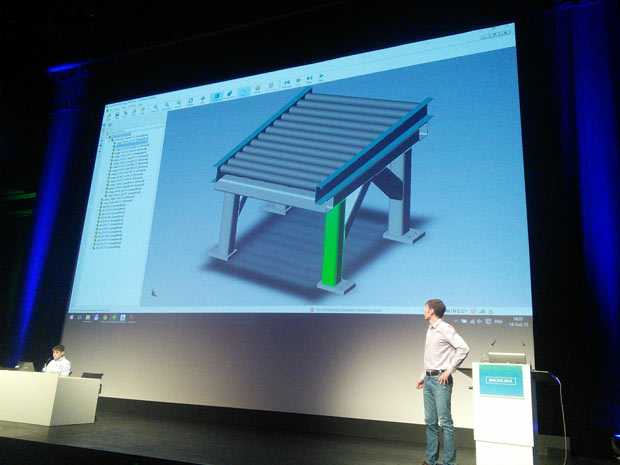 Two members of the Bricsys Technologies Russia team demonstrate the latest features of BricsCAD for mechanical engineering at the recent Bricsys Developers Conference in Munich. Image courtesy of Randall S. Newton.
Two members of the Bricsys Technologies Russia team demonstrate the latest features of BricsCAD for mechanical engineering at the recent Bricsys Developers Conference in Munich. Image courtesy of Randall S. Newton.Bricsys believes in DWG for 3D work, in both mechanical and AEC. AutoCAD only offers constraints technology in 2D, but BricsCAD also offers 3D constraints. “Autodesk pushes 3D, and we believe it as well,” says Bricsys CEO Erik de Keyser. “But we take another approach to fulfill it. We deliver 3D on DWG. Direct modeling is disruptive for 3D.” Bricsys extends its full-on DWG approach to 3D design with software for direct import of the leading 3D modelers. “We are the center point for all the exotic file formats in the mechanical industry,” says de Keyser. “We are not the only ones in direct modeling, but our use of DWG is a clear advantage.”
Three years ago Bricsys acquired software and a development team from Ledas, a Russian developer. The new team made an immediate impact on Bricsys development, but the full measure is only now coming to market. This month’s release of BricsCAD Platinum is filled with new tools and techniques for mechanical drafting/modeling including special features for sheet metal work. “The feature tree is not the central point” of BricsCAD for mechanical design, says Dmitry Ushakov, CEO of Bricsys Technologies Russia. “Geometry is the key.” There is support for surface entities, which is “important in aerospace,” says Ushakov. “Our surface modeling is not a repeat of others, it is unique technology,” he says.
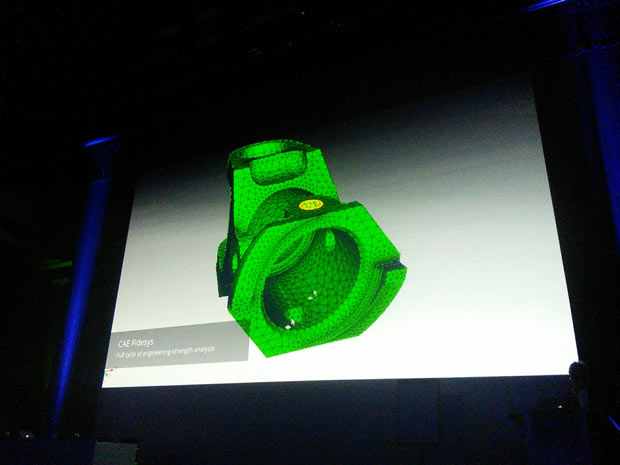 CAE Fidesys is multiphysics engineering analysis software based on BricsCAD. Image courtesy of Fidesys LLC.
CAE Fidesys is multiphysics engineering analysis software based on BricsCAD. Image courtesy of Fidesys LLC.It’s Not About Clones Anymore
The segment of the engineering software industry devoted to compatibility with the DWG fire format is much larger than Graebert and Bricsys. The Open Design Alliance, maker of the Teigha development platform used to build applications compatible with DWG, has more than 1,200 members. At one time, software vendors sought to be DWG compatible for only two reasons: to sell CAD software cheaper than Autodesk, or to allow import/export of AutoCAD files. It could be argued the rise of companies like Graebert and Bricsys has validated DWG as a file format standard with a reach far beyond the Autodesk customer base.
Both Graebert and Bricsys offer their CAD software at prices closer to AutoCAD LT than AutoCAD. But price is only one aspect of a buyer’s decision process. A fresh look at the alternatives may lead design teams to decide they can have their legacy file compatibility and modern design tools in one product.
Subscribe to our FREE magazine, FREE email newsletters or both!
Latest News
About the Author
Randall S. Newton is principal analyst at Consilia Vektor, covering engineering technology. He has been part of the computer graphics industry in a variety of roles since 1985.
Follow DERelated Topics







